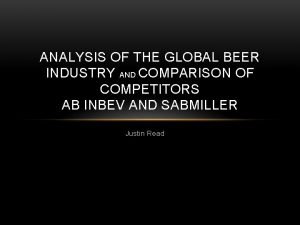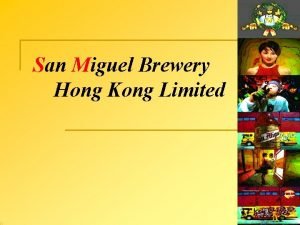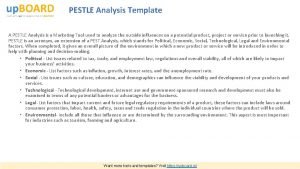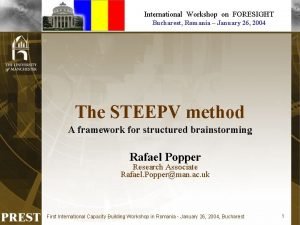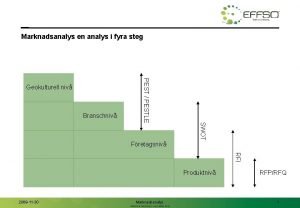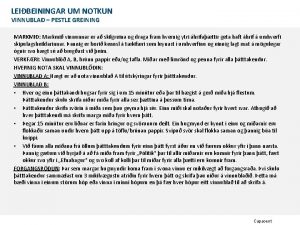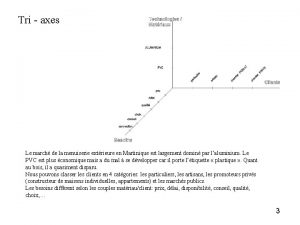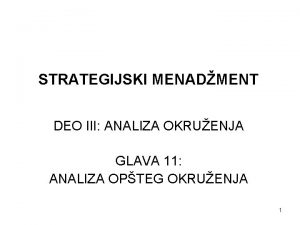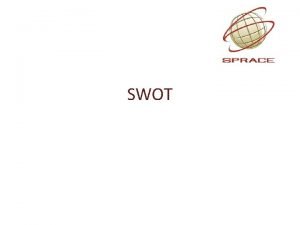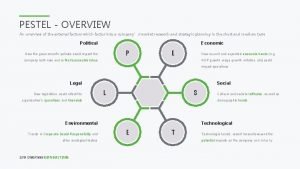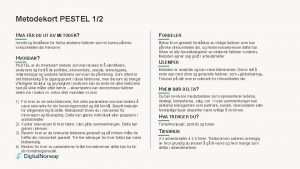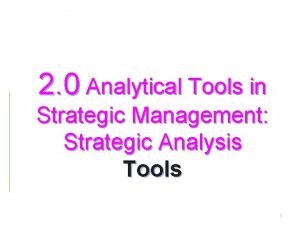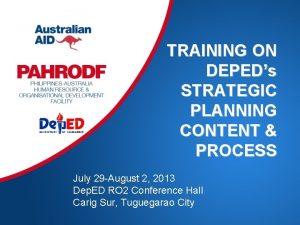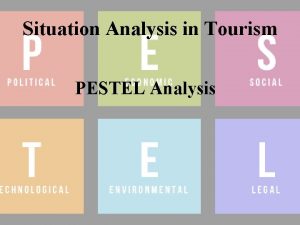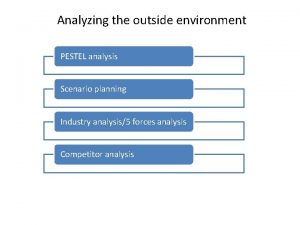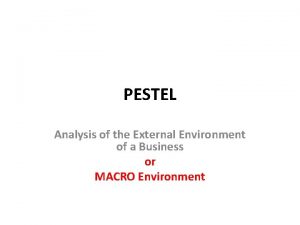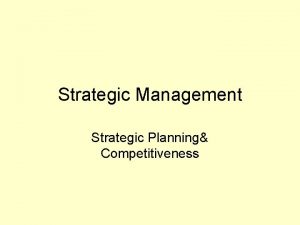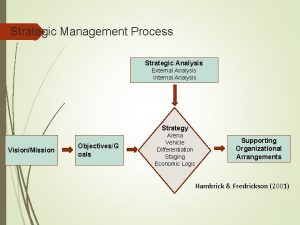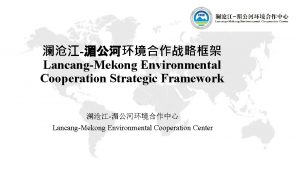PESTEL FRAMEWORK Environmental Analysis Strategic Management STEEPV FRAMEWORK







































- Slides: 39

PESTEL FRAMEWORK Environmental Analysis (Strategic Management)


STEEPV FRAMEWORK


Analysis of External Environment of Business • Strategies are not and should not be developed in a vacuum. • They must be responsive to the external environment of business. • The managers must be aware of what’s going on outside their company. • If the firm focus only on internal environment, they may be efficient producers of goods or services but not for the market. • Many high-tech companies fail mainly because of their inefficiency to cope with the changes that is happening in the environment

Analysis of External Environment of Business • So a manager must be able scan the environment and forecast the environmental variables so as to create an environmentally aware organization. • Managers can become environmentally aware by following three important processes as given below: Environmental Scanning Environmental Monitoring Competitive Intelligence Forecasts

Environmental Scanning • This involves surveillance of a firm’s external environment so as to enable the firm to predict external environmental changes and detect those changes which is already underway. • The environment of business is broadly classified as Micro Environment and Macro Environment. • The micro environment or direct environment consists of those environmental variables which are very closed and directly related to business. This comprises of suppliers, distributors, customers, governmental agencies, pressure groups etc. which is generally called as stakeholders in business • The macro environment consists of broad spectrum of factors that are general in nature but affect and get affected by business.

Components of General Environment • The Demographic Segment • Demography is the study of population and its related parameters. • The major such characteristics that affect business are population size, age composition of the population, literacy levels, inter-state migration, rural-urban mobility, income distribution etc. • For example, the growing number of senior citizens in a country can affect the general business. Example: Japan

E. g. Aging Population in Japan • Old age could be a fountain of trouble for Japan • Respect for the Aged Day is symbolic of the respect that is afforded to the elderly in Japan. But with one in four of its population aged 65 or over, the country is facing what experts suggest is a demographic time bomb.

Example: Aging Population in Japan • Taro Aso, the finance minister, said on Monday that the elderly should be allowed to "hurry up and die" to relieve pressure on the state to pay for their medical care. • The aging of Japan is thought to outweigh all other nations, as the country is purported to have the highest proportion of elderly citizens; more than 24% are aged 65 or above, as of 2012 • According to the health ministry, there were 153 centenarians in Japan in 1963, when the survey began. While it took 35 years to top 10, 000 in 1998, the number has grown rapidly since, surpassing 30, 000 in 2007 and 50, 000 last year. (Think about the impact on business due to aging population)

Aging Population in Japan

Political Factors • Politics has a serious impact on the economic environment of a country. • Political ideology and political stability or instability strongly affect the pace and direction of economic growth • This also influence the economic environment of a country. For example, the new government in India in 1991, opened up the economy through various economic measures that really changed the face of the economy. • Certain political philosophy affect the business adversely as Coca Cola and IBM had to move out of India due to the policies of the Janata Government during late 1970 s.

Political Environment • The major political factors that influence business are: 1. Government stability 2. Political values and beliefs shaping policies 3. Regulation of trade and business 4. Taxation policies of the government 5. Priorities in social sector 6. Political parties and trade unionism


Political Environment – Corruption at Government Level and Impact on Economy : Black Money • In a country like India, it is said that dishonest industrialists, scandalous politicians and corrupt IAS, IRS, IPS officers have deposited in foreign banks in their illegal personal accounts a sum of about $1500 billion, which have been misappropriated by them. This amount is about 13 times larger than the country's foreign debt. With this amount 45 crore poor people can get Rs 1, 000 each • TOP FIVE IN BLACK MONEY IN SWISS BANKS • INDIA $1, 456 BILLION • RUSSIA $470 BILLION • U. K. $390 BILLION • UKRAINE $100 BILLION • CHINA $96 BILLION (Think : Impact of Political Environment on Economic Environment of Business)

Economic Factors • Economic factors give guidelines on the nature and direction of the economy in which the firm operates. • The firm must frequently scan and monitor the economic trends in a country. • For example, the trend of price changes (inflation), FDI flow, economic fluctuations etc are very important factors that determined the fate of a firm in a market.

Economic Factors • The common economic indicators are: • • National Income Savings Policy Initiatives Capital Market and Money Market Prices, Wages and Productivity Sectoral Growth Economic Fluctuations Balance of Payment Position & Foreign Trade

THINK : MONEY SPEND ON MAINTAINING PRISONS AND ITS IMPACT ON BUSINESS

SOCIO-CULTURAL FACTORS • Socio cultural factors influence the values, beliefs, and lifestyles of a society. • For example, a higher percentage of women in the workforce, dual income families, increase in number of temporary workers, greater concern for healthy diets and physical fitness etc influence business • Culture and business is closely interrelated in the sense that when a new business starts, it will be based on the concept of cultural adaptation. • Once the product or service is accepted, the company will go for cultural transformation.

THINK: INFLUENCE OF CULTURE ON DOING BUSINESS IN CHINA

Technological Factors • Technological factors represent major opportunities and threats which must be taken into account while formulating policies. • Technological change can influence an organization’s products, services, suppliers, distributors, competitors, customers, manufacturing process, marketing practices and competitive position etc. • Technological changes can reduce or eliminate cost barriers between businesses, create shorter production runs, create shortages in technical skills and result in changing values and expectations of customers and employees.

Technological Factors • Certain technological factors that influence business are: 1. Bio-technology 2. Process innovation 3. Digital revolution 4. Government spending on research 5. Speed of technology transfer 6. Rate of obsolescence 7. Development in information technology

THINK: IMPACT OF GENETIC MODIFICATION ON BUSINESS

ENVIRONMENTAL FACTORS • The impact of business on environment is a major concern now globally. • The issue has gained the attention of governments globally as the impact of business has negatively affected environment in many countries of the world. • This forced many companies to take up Corporate Social Responsibility (CSR)

Environmental Factors • The major environmental issues are: – Waste – Sustainable development of raw materials – Emissions

THINK: ADVERSE IMPACT OF BUSINESS ON ENVIRONMENT

Legal Factors • Legal factors have got substantial impact on business, both positively and negatively • Governments introduce rules and regulations for controlling business activities along with supporting activities. • The major legal issues pertain to the following in many countries: 1. Licensing policies 2. Quota restrictions 3. Import duties 4. Forex regulations 5. Restriction on FDI flow 6. Control on distribution and pricing

THINK: LAWS CONTROLLING BUSINESS AND SUPPORTING BUSINESS

PESTEL FRAMEWORK • Careful analysis of the factors given in the earlier slides will help you in identifying the environmental factors that affect your business • The above information can be analyzed and recorded with the help of PESTEL framework, which is a popular tool used for assessing the impact of business enviornment.

PESTEL FRAMEWORK • These external forces affect the consumer demand for the product, that products that are produced by companies, the nature of positing the products or services etc. • So it is imperative for organization to identify OPPORTUNITIES and THREATS that is posed by the environmental factors.

PESTEL FRAMEWORK P E S T E L OLITICAL CONOMIC OCIO-CULTURAL ECHNOLOGICAL NVIRONMENTAL EGAL

GRID FOR PESTEL ANALYSIS • Consider the factors that influence your business • Plot it horizontally in the grid • Consider the individual factors that govern your business and its success or failure • Analyze the impact of environment on your business so that steps can be taken to overcome the weaknesses and thereby improve the strengths

PESTEL ANALYSIS GRID Political Int ern a tio na l National Economic Social Technological Environmental Legal

PESTEL ANALYSIS GRID • Consider both positive factors and negative factors that has got impact on business. • Give weights to negative and positive factors. For negative factors, give negative sign and positive factors given positive sign. • Think about ways that can help to reduce the impact of negative factors and improve the effect of positive factors

PESTEL ANALYSIS GRID • For analyzing the effect of negative factors and positive factors, use FORCE FIELD ANALYSIS. • Force Field Analysis was created by Kurt Lewin in the 1940 s. • Lewin originally used the tool in his work as a social psychologist. Today, however, Force Field Analysis is also used in business, for making and communicating go/no-go decisions. • You use the tool by listing all of the factors (forces) for and against your decision or change. You then score each factor based on its influence, and add up the scores for and against change to find out which of these wins. • You can then look at strengthening the forces that support the change and managing the forces against the change, so that it's more successful.

Force Field Analysis (Refer Material on Force Field Analysis) • For making force field analysis, ask the following questions to yourself. • What business benefit will the change deliver? • Who supports the change? Who is against it? Why? • How easy will it be to make the change? Do you have enough time and resources to make it work? • What costs are involved? • What other business processes will be affected by the change? • What are the risks?



Segment/Trends & Events Industry Positive DEMOGRAPHIC Aging Population Healthcare Baby Products Rising Affluence Brokerage Service Fast Foods Upscale Pets & Supplies SOCIO CULTURAL More Women in Service. Clothing Baking Products (Staples) Health & Fitness Concern Home Exercise Equipment Meat Products POLITICAL & LEGAL Legal Regulations Legal Service Exports & Imports Political Ideology FDI TECHNOLOGICAL Genetic Engineering Pharmaceutical Publishing Neutral Negative Pollution/Global Warming Engineering Services Petroleum ECONOMIC Interest Rate. Residential Construction Grocery Products GLOBAL Increasing Global Trade Shipping Personal Service China as an Economic Power Defence Softdrinks Automobiles
 Steepv framework
Steepv framework Steepv framework
Steepv framework Analysing the 6 strategic options megxit
Analysing the 6 strategic options megxit Pestel analysis beer industry
Pestel analysis beer industry Pestle analysis
Pestle analysis Strength of san miguel
Strength of san miguel Pestle analysis template doc
Pestle analysis template doc Ford pestel analysis
Ford pestel analysis Strategic management and strategic competitiveness
Strategic management and strategic competitiveness Steepv
Steepv Sociocultural pestel
Sociocultural pestel Pestle modellen
Pestle modellen Pestle greining
Pestle greining Pestel menuiserie
Pestel menuiserie Eslogan de bic
Eslogan de bic Pest analiza primeri
Pest analiza primeri Swot cosmétique bio
Swot cosmétique bio Pestle analiza primjer
Pestle analiza primjer Swot manpower
Swot manpower Manon pestel
Manon pestel Metodekort
Metodekort Role of sidbi
Role of sidbi Pestel
Pestel Manon pestel
Manon pestel Porter féle 5 erő
Porter féle 5 erő Francis aguilar pestel
Francis aguilar pestel Swot elemzés
Swot elemzés Pest analyse automobilindustrie
Pest analyse automobilindustrie Porter 5 erő
Porter 5 erő Mh 605
Mh 605 Strategic management tools
Strategic management tools External analysis in strategic management
External analysis in strategic management Strategic fit vs strategic intent
Strategic fit vs strategic intent Puppy dog ploy strategy
Puppy dog ploy strategy Spatres
Spatres Medium term strategic framework (2019 - 2024)
Medium term strategic framework (2019 - 2024) Fao strategic framework
Fao strategic framework Contingency framework for strategic sports marketing
Contingency framework for strategic sports marketing A framework for strategic sustainable development
A framework for strategic sustainable development Conceptual framework of human resource development
Conceptual framework of human resource development



